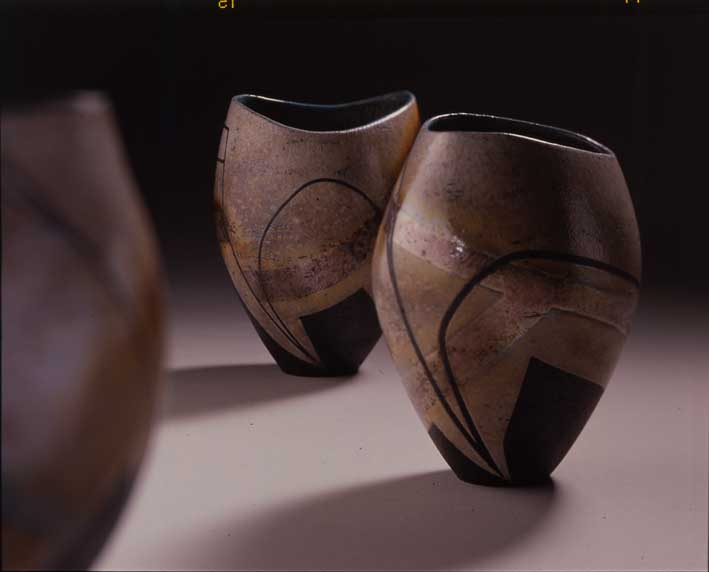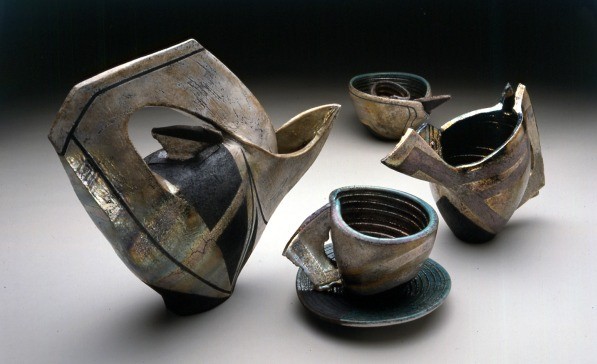

Deconstructed Tea Bowls and Deconstructed Teaset were pieces shown in the exhibition Raku-Harmony of Earth, Water and Fire, which were sent from the UK and created on-site in Daegu, Korea, in inspired by the culture and environment. My work was inspired by drinking vessels – both oriental tea-bowls (created for Tea-Ceremony) and the iconography of the English consumption of tea, to examine the history of the raku technique and its contexts.
Raku
Raku evolved in Japan, in the 17th. century, as a reaction to the demand for utensils for Chanoyu (also known as the Japanese Tea Ceremony), which was quite the antithesis of the previous ritualised court tea drinking practice at court which had been heavily influenced by the Chinese (in terms of both the actions and the exquisite utensils). Chanoyu developed out of Zen practice, and was governed by the code of wabi-sabi which is an aesthetic of austerity and restraint, derived from Zen teaching that suggests value in that which is imperfect, impermanent, or incomplete (Suzuki, 1973; Juniper, 2003). Briefly Tea Ceremony involves the preparation of a drink; it utilises powdered green tea, whipped with a little boiling water, in asymmetric vessels (as opposed to the leaf tea employed in the Chinese style of tea drinking at the Japanese court which used exquisite porcelain utensils). In the 17thcentury Sen-no Rikyu (the Shogun’s advisor) chose the utensils from the spoil heaps of Japanese kiln sites; he selected the discarded pots (over-fired, stuck together, glaze runs, collapsed under extreme heat, etc. Thus in a precursor to the 20th.century re-purposing and nomination of found objects, practiced by Duchamp, the pieces were appropriated for use in the newly developed Tea-Ceremony. My critical appreciation of these elemental ceramic and conceptual qualities evolved into the concept of embodied narrative. Raku was first devised in medieval Japan; Sen no Rikyu collaborated with the potter Korean potter Chojiro, who was the first to be awarded the name “Raku” . Their joint interpretations of the new ritualised way of preparing the drink, informed the creation of a special sort of ceramic, for the Tea Ceremony.
This Japanese Raku technique of firing involved rapid heating and cooling; this requires very coarse clay to withstand the extreme changes of temperature. The pot was removed red-hot from the kiln and quenched in water, causing the glaze to craze – acquiring the desired wabi-sabi qualities of agedness via this intervention in the firing. Using these new utensils Chanoyu developed in Japan to a most rarefied elevation of the everyday, influenced by Zen philosophy; it was a choreographed focus on the here-and-now in the drinking of tea. The tea-utensils manufactured in 17th.century Japan, hand-built and thrown loosely on the wheel, referenced archaic qualities and established a new aesthetic, that has proven highly influential in 20thcentury ceramics, which resonates strongly in my work. They were the focus of a highly ritualised appreciation of the utensils that was codified within Chanoyu, in which the haptic quality of the vessels is appreciated by passing the tea-bowl from hand to hand, amongst the participants.
Throughout the subsequent centuries Tea-Ceremony and raku firing practice was formalised in Japan; raku was rediscovered, and then reinvented, in Europe and the USA at the beginning of the 20th century. Raku was introduced and re-codified by Bernard Leach at the beginning of the 20th century for a British audience. Leach wrote about Raku firing in his A Potter’s Book, the first book for studio potters. This account was re-interpreted again by Paul Soldner in the USA in the 1960’s as a form of Abstract Expressionism or Happening. Soldner invented the process of secondary reduction, where the pots are removed red-hot from the kiln and plunged into sawdust (Soldner, 1990). This is celebrated as accident, a free-marking of the surface of the ceramic by fire and smoke; it was embraced as an aspect of Zen here and now, that fitted the Zeitgeist of the 1960s.
I have refined some of Soldner’s processes in my own interpretation of raku in the creation of a particularly lustrous, blackened, charred surface. Raku involves a particularly close association of potter and vessel during the firing process. In my work there are similarities with the Japanese methodology of making, and profound differences: I first paint the unglazed surfaces of the clay with a terra-sigillata slip that produces a sheen of deep blackness after reduction; I interrupt the glaze melting, by removing the pot red-hot from the kiln, with gloves and/or metal tongs, and the piece is processed by treating the reactive surface with combustibles and water. After some hours, when the piece is cold, it is removed from the smothered sawdust which leaves the surface of the clay heavily blackened and burnt through contact with carbonised sawdust. It is this narrative of fire embodied in the vessel that became the ceramic language of meaning burnt into ceramics, which generated the conceptual framework to create my later installations.
—————–
It was a group exhibition including participants from Korea alongside a group of international artists that I had helped to select through my contacts established from my authorship of Raku – Investigations into Fire.[1] I assisted in the curating of the exhibition and symposium. My pieces investigated the possibility of using the traditions and history of raku to inspire contemporary work. The oriental heritage of the technique was a central concern of the symposium, and became a focus of dispute between the Japanese and Korean hosts; Korea is regarded as the place of birth of the first potter to be given the family name of Raku. (It was ironic that the technique manifested in the contemporary work was predominately in the tradition of American raku which is itself a radical deviation from the Japanese tradition, and also the subject of disputed nomenclature [Soldner]).
The ceramic vessels shown in Raku Harmony (2001) were significant as my practice at that time embodied a re-interpretation of the Japanese concept of wabi-sabi.[2] My overriding concern was interpretative and technical – involving the way in which it was possible to manipulate glaze surfaces through the raku firing process to develop lustres and patinas that connoted apparent age, while using fast-firing techniques. My use of the raku methodologies of firing created surfaces that were burnt and corroded as well as referencing the luxurious qualities of Chinese and Korean court ceramics. My work continued an investigation not merely into the sculptural suggestiveness of the Chawan (the Japanese tea-bowl) but also referencing my own tradition of tea – i.e. a non-functional reading of the English tea-set as an icon for interpretation. The critical consideration of these two environments – Tea House and English vernacular domestic – was the germ of the ideas that were developed in the later installations.
[1] Amongst other artists invited to the symposium were: Richard Hirsch, Harvey Sadow from USA; 10th.Chozaemon Toshiro Ohi a living National Treasure from Japan and his son Toshio Ohi, (the Ohi family is a dynastic sister kiln to the Raku family in Japan); Rina Kimche of Israel; Ching-Yuan, Chang from Taiwan; Prof. Young-Shick Kwon, Professor Sun Kim, Professor Hee-Soon Lee, from Korea.
[2] Wabi sabi is an aesthetic attitude derived from Zen which finds value in the everyday and in the poor and shabby (see the discussion in: Jones Raku, 1999, p11)